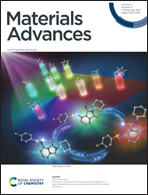Strain-controlled single Cr-embedded nitrogen-doped graphene achieves efficient nitrogen reduction†
Abstract
Single atom catalysts (SACs) have received much attention in the nitrogen reduction reaction (NRR) field due to their high atomic utilization and controllable electronic state regulation. It is attractive to explore the mechanism for regulating the electronic state of the active center of single-atom catalysts. Herein, we propose a new regulation mechanism by applying a strain that can change the coordination bond length of Cr–N and quantitatively regulate the electronic state of the active center in Cr-SACs. Based on this mechanism, we achieve an ultra-low 0.174 V over-potential for the NRR in the single Cr-embedded nitrogen-doped graphene (CrN3@graphene) by applying lattice stretch of 2.5% compared to the pristine CrN3@graphene. Computational results show that the d band center, the Cr–N anti-bonding orbital and the spin-polarization state of the single Cr atom can be adjusted by tuning the coordination length of Cr–3N. The applied lattice stretch of 2.5% can transform the spin-polarization state of the single Cr atom from a high-spin-polarization state to low-spin-polarization. This conversion weakened the adsorption capacity of N2 for CrN3@graphene and finally achieved an ultra-low over-potential. Our findings open up a new path of NH3 production by exploiting strained SACs under ambient conditions.



 Please wait while we load your content...
Please wait while we load your content...